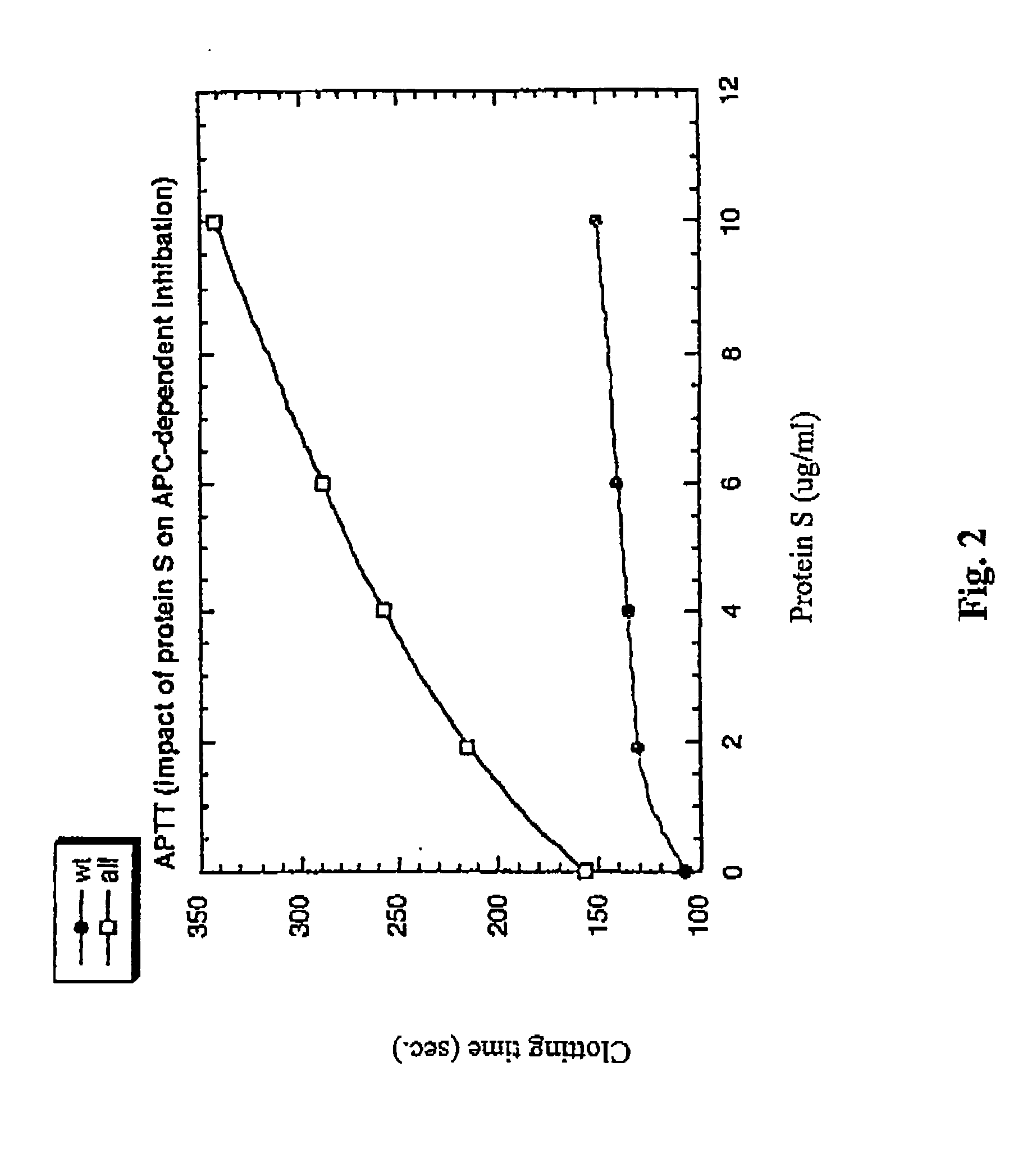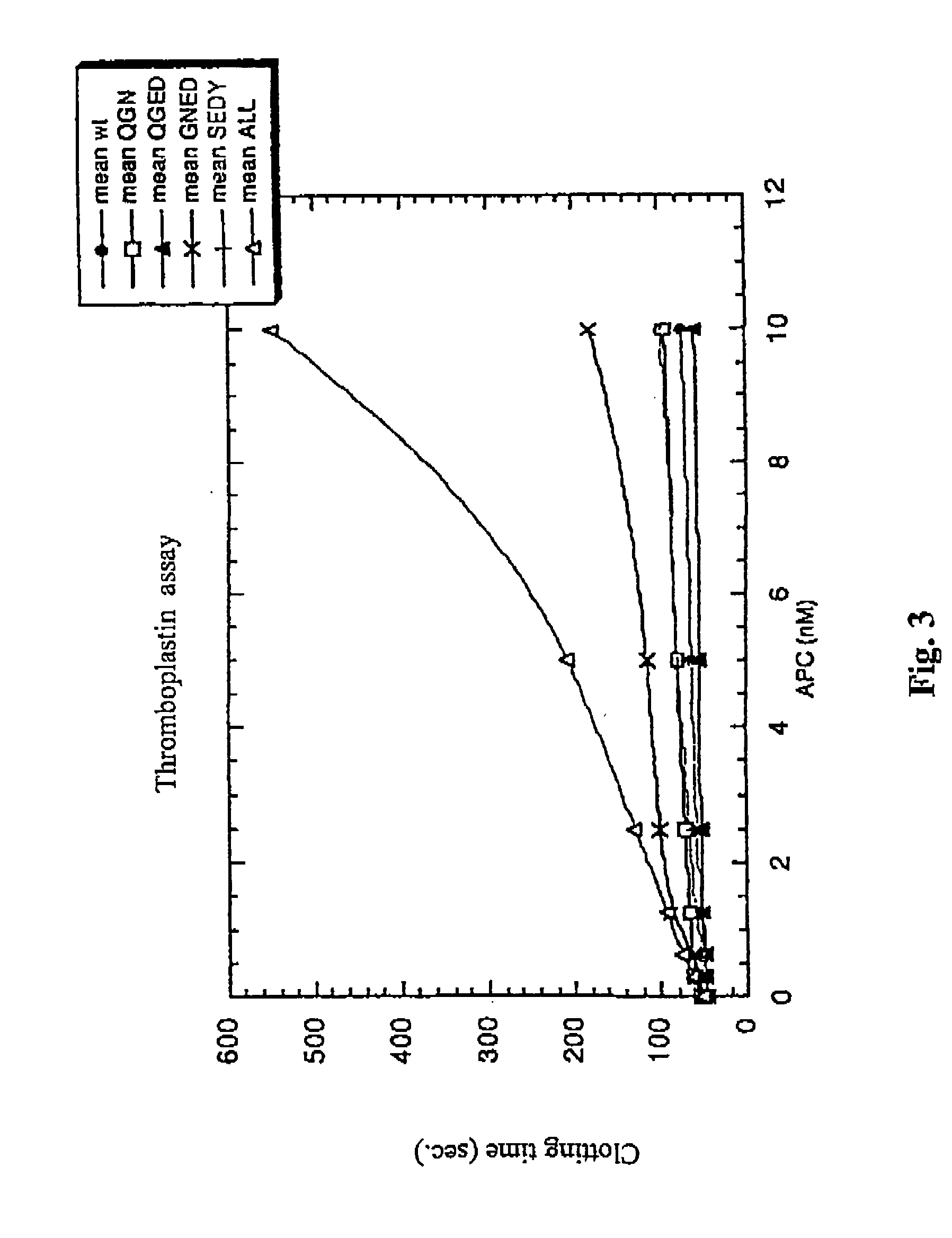Protein C variants
- Summary
- Abstract
- Description
- Claims
- Application Information
AI Technical Summary
Benefits of technology
Problems solved by technology
Method used
Image
Examples
example 1
Preparation of Variants of Protein C
[0135] (a) Site Directed Mutagenesis
[0136] The various protein C variants used in this study were created with recombinant technologies essentially as described previously by Shen et al (J Biol Chem 1998,273: 31086-31091 and in Biochemistry 1977, 36 16025-16031).
[0137] A full-length human protein C cDNA clone, which was a generous gift from Dr. Johan Stenflo (Dept. of Clinical Chemistry, University Hospital, Malmö, Sweden), was digested with the restriction enzymes HindIII and XbaI and the resultant restriction fragment comprising the complete PC coding region, that is full length protein C cDNA, was cloned into a HindIII and Xbal digested expression vector pRc / CMV.
[0138] The resultant expression vector containing the coding sequence for wild-type human protein C was used for site-directed mutagenesis of the Gla-module of protein C, wherein a PCR procedure for amplification of target DNA was performed as described previously (Shen et al., supr...
example 2
Characterization of Protein C Mutants
[0161] To characterize the protein C mutants obtained in the previous steps, mutant and wild-type protein C's were activated and their anticoagulant activity was tested in different experimental systems, including plasma-based assays and set ups with purified components.
[0162] Two plasma systems were tested, one being the activated partial thromboplastin time (APTT) system and the other being the thromboplastin (TP) system. In both the APTT and the TP systems, the anticoagulant activity of increasing concentrations of wt or mutant APCs was tested. In the APTT system, the anticoagulant activity of APC is dependent both on FVIIIa and FVa degradation, whereas the TP system is mainly sensitive to FVa degradation. However, the diluted TP system is to some extent sensitive also to degradation of FVIIIa
[0163] (a). Inhibition of Clotting by APC Variants as Monitored by an APTT Reaction
[0164] (i) Method: Plasma (50 μl) was mixed with 50 μl APTT reagen...
example 3
Inactivation of FVa by APC
[0179] In this example, the enhanced activity of the APC variant QGNSEDY was established in a system, designed to more specifically characterize the degradation of FVa and wherein the loss of FVa activity over time is demonstrated.
[0180] (i) Method: Plasma FVa (0.76 nM) (plasma was diluted {fraction (1 / 25)} and FV contained therein was activated by the addition of thrombin—this was used as the source of FVa) was incubated with APC (0.39 nM) in the presence of 25 μM phospholipid vesicles (mixture of 10% phosphatidylserine and 90% phosphatidylcholine). The buffer was 25 mM Hepes, 0.15 M NaCl, 5 mM CaCl, pH 7.5, and 5 mg / ml BSA and the temperature was 37° C.
[0181] At various tine points, aliquots were drawn and the remaining FVa activity was determined by a FVa assay. This assay was based on the ability of FVa to potentiate the FXa-mediated activation of prothrombin. This assay contained bovine FXa (5 nM final concentration), 50 μM phospholipid vesicles (mi...
PUM
| Property | Measurement | Unit |
|---|---|---|
| Fraction | aaaaa | aaaaa |
| Fraction | aaaaa | aaaaa |
| Fraction | aaaaa | aaaaa |
Abstract
Description
Claims
Application Information
 Login to View More
Login to View More - R&D
- Intellectual Property
- Life Sciences
- Materials
- Tech Scout
- Unparalleled Data Quality
- Higher Quality Content
- 60% Fewer Hallucinations
Browse by: Latest US Patents, China's latest patents, Technical Efficacy Thesaurus, Application Domain, Technology Topic, Popular Technical Reports.
© 2025 PatSnap. All rights reserved.Legal|Privacy policy|Modern Slavery Act Transparency Statement|Sitemap|About US| Contact US: help@patsnap.com



